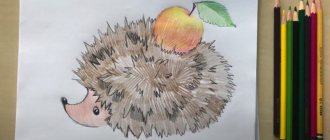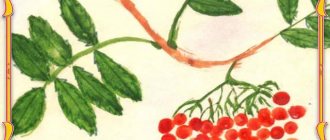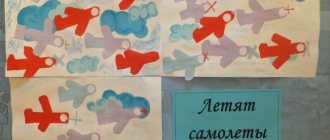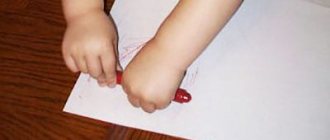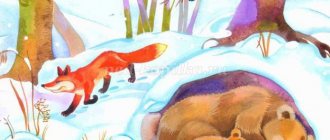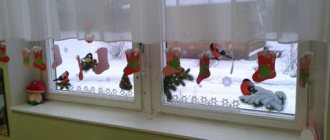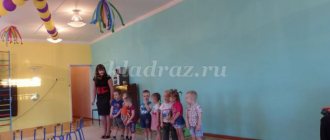Volumetric applique of autumn forest
This method requires some skills and is accessible to children of primary school age.
Take white birch paper and draw black marks. For a voluminous central trunk, cut a strip of 9x17 centimeters and screw it into a tube onto a marker, gluing the edge so that the tube retains its shape.
Attach strips of 10x4 centimeters in the same way, using a pencil, to get thinner tubes. Roll the paper along the long edge, so you will get a thick tube 17 centimeters long and several thin ones 10 centimeters long.
Glue them in the form of a central trunk with branches on the sides. Using a template or a hole punch, cut out leaves from paper in autumn shades and attach them evenly along the branches.
For originality, you can add autumn fruits, such as apples.
Application on the theme “Trees” for children of the preparatory group: instructions and useful tips
Children of the preparatory group can make an applique on the theme “Trees” not only from paper, but also from plasticine. But first things first.
First, let's see how to make an applique from colored paper:
- To do this, you need to take a sheet of brown paper. If it is not monochromatic, but with small third-party inclusions, it’s okay. A tree is drawn on the selected sheet. You can use ready-made templates if available. But still, if a child draws a tree on his own, it is much more useful.
- Next, carefully cut out the drawn tree with scissors.
- The approximate height of the tree will be 20 cm from an A4 sheet. Then we prepare the leaves: you need to cut squares of different colors about 3cm x 3 cm. After the leaves, you make a preparation for the grass - a green rectangle 2cm x 28 cm. The squares need to be folded like an accordion, starting from the corner. The grass blank should also be folded like an accordion, but in width.
- When the blanks for the tree itself are ready, you need to make a small mound on which the tree grows. To do this, fold a green rectangle 9cm x 4cm in half. Use scissors to cut along an arc. Unfold - you get a regular semicircle. Now you need to complete the formation of foliage. Bend the accordion, which is made from colored squares, in half and glue it in the middle. Glue a cut out mound to the center of the bottom edge of a sheet of blue cardboard. In the center of the mound, retreat 1.5 cm from the bottom of the cardboard sheet. Glue the wood blank. Stretch the accordion of grass along the entire length of the bottom edge of the cardboard. The grass should cover the “roots” of the tree.
- Now the formation of the tree crown begins. You need to glue the leaves, trying to ensure that the colors do not go in a row. More leaves mean a more luxuriant crown. You can stick a couple of leaves that are not attached to anything, creating the effect of leaves torn off by the wind and floating in the air. All that remains is to make the sky. In fact, the sky itself already exists - the cardboard is blue, there is no need to highlight the sky on it. But the clouds will need to be made. For this, take blue paper. You can cut out the clouds, or you can simply tear the paper into small pieces. All that remains is to glue them to the top of the cardboard without any order.
The tree against the background of the autumn sky is ready, mind you, without any effort. But, if you want to complicate the drawing, it all depends on who is doing the appliqué. There would be a desire. The pictures below show several options, which are also quite simple to do.
How to prepare leaves
In order for the application to be neat and stored for a long time, the leaves must be prepared in advance. Drying in a loose position will not help; as moisture evaporates, the material will curl. Gluing such leaves is much more difficult, as is cutting out even shapes for a modular applique of leaves.
There are two options for drying natural material. You can put the leaves under a press, for example in a large book. But we must take into account that the pages are deformed, even if they are additionally padded with a napkin - the reason is evaporating natural moisture. Such drying is a long process, taking at least a month. Solid large veins should be cut lengthwise in advance so that they dry and do not begin to rot.
Express drying with an iron is much faster. It is enough to place the leaves on a newspaper and iron at medium temperature. In this case, the natural color may be distorted. To prevent this from happening, it is worth drying in several stages and not setting the iron to maximum.
To prevent the material from deteriorating before class, you can store it in a box with salt or rice sprinkled on the bottom. The absorbent will absorb residual moisture and prevent rotting.
Applications for school
The difference between the program for schoolchildren and the application for children 4-5 years old is greater freedom of creativity. The teacher distances himself as much as possible, inviting students to independently choose the plot, characters and implementation of their own ideas. He can only suggest methods for implementing unusual techniques.
Templates are also abandoned when working with school-age children. They are already able to draw animal faces and silhouettes on their own. You can only suggest characteristic details - remind that the mouse needs a long tail, and the squirrel needs tassels on its ears.
Crafts with natural materials
Natural materials can also be used to create applications. Most often, they are collected leaves of various trees, which are perfect for such purposes. For crafts, it is important to choose only the most beautiful ones. This will help improve the quality and beauty of the future product.
Golden autumn
Children need to be taught creative work from a very early age. In kindergarten, for these purposes, various crafts are used from natural material that has been collected and properly dried.
An application on the theme of autumn in the younger group involves the use of multi-colored autumn leaves, which the children themselves chose and brought. It doesn’t matter what size or shape they are. To try to make a beautiful craft, you need to prepare:
- glue and a brush for applying it;
- cardboard or thick paper for the base;
- scissors;
- natural natural materials (leaves, twigs, flowers);
- small decorative elements.
For this craft, it is advisable to collect leaves from different trees. This will not only help make a more beautiful picture, but will also allow educators to teach children to distinguish them from each other.
The golden autumn applique is made following the following sequence of actions:
- First, the children collect the leaves and other natural materials they like.
- Then only the highest quality and most attractive specimens are selected from the total mass. All rotten, dried or damaged leaves are removed and disposed of.
- Selected specimens are laid out on the work surface and dried from excess moisture. It is important not to overdo it, so as not to end up with pieces that are brittle and unsuitable for application.
- After this, a cardboard base is taken and a rectangle of the required size is cut out of it.
- Then the brush is moistened in a jar of glue and the leaves are coated one by one.
- Immediately the image details are attached to the base. This should be done chaotically and in random order.
- The finished composition is transferred to a warm place for the glue to dry completely.
- At the very end, the applique is supplemented with various decorative elements.
